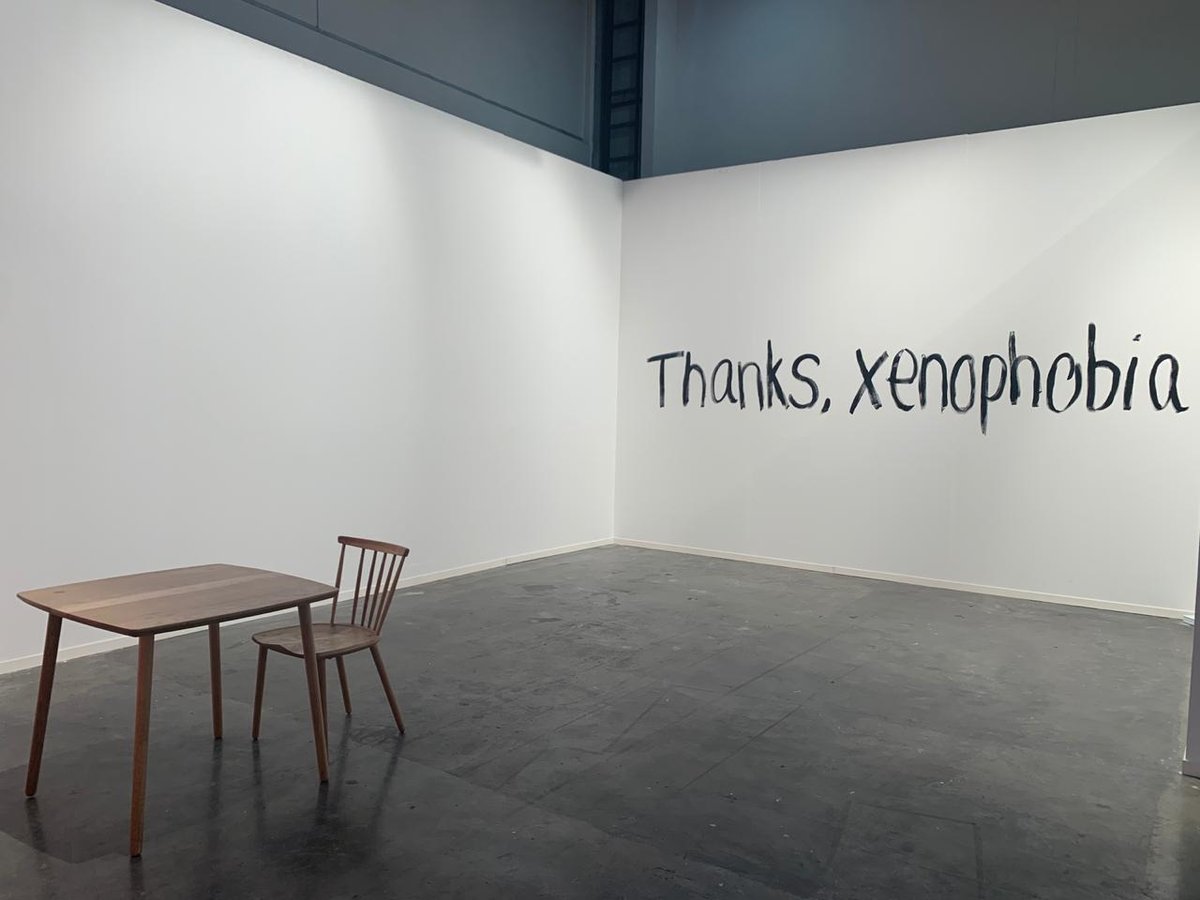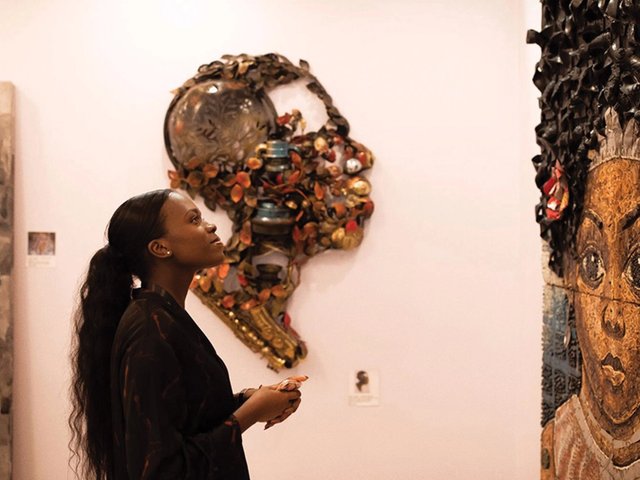“Thanks xenophobia” is the stark message painted on the back wall of the Nigerian gallery 16/16’s empty booth at FNB Art Joburg. The gallery, along with Revolving Arts Incubator, both from Lagos, failed to obtain visas to enter South Africa after xenophobic violence spread across Johannesburg last week, sparking retaliation in Nigeria. A third Nigerian space, Rele Gallery, was granted a visa the day before the fair opened on Thursday.
The latest wave of attacks, said to have been started by a group of black South Africans called the Sisonke People’s Forum, broke out in Johannesburg in late August targeting African foreign nationals, who are being blamed for poverty, lack of jobs and social inequality in the country. Migrants from Nigeria, Malawi, Zimbabwe and Mozambique are among those affected. At least 12 people are reported to have been killed.
The violence sparked reprisal attacks against South African firms in Nigeria, forcing the South African embassy in Lagos and the high commission in Abuja to close down on 4 September. “There is a lot of anger in Nigeria right now, the racial element to the attacks in South Africa is very sinister,” says Tushar Hathiramani, the founder of 16/16, adding: “I am shocked and sad to be caught in the middle.”
The graffitied message in his booth is a work by the Nigerian artist Sheila Chukwulozie who was due to show at the fair. She says in a statement: “The first time I applied for my South African visa they had guards come out with a horse whip and [were] whipping the Nigerians who weren’t sure why it was taking so long to open the gate. The second time we came back, the security had sprayed tear gas.”
Hathiramani describes the protest piece as a collaboration with the fair and the South African gallery, Stevenson, whose director, Joost Bosland, sourced a painter and a copy of the Star newspaper, which ran the headline “Nigerians flee SA” on 12 September. The paper was laid on the floor of 16/16’s booth on the opening day of the fair.
Chukwulozie’s protest message comes with a price tag of $10,000, which Hathiramani says should be thought of as “commentary, and not necessarily within the realm of traditional fine art values”, nor is it “the price of getting rid of xenophobia” . He adds: “Any buyer might be interested in pursuing conversations around this.”
The project has already sparked a dialogue, with plans to present an expanded version in Lagos in November. Hathiramani says he intends to collaborate with Stevenson gallery on an exhibition of works created in response to the attacks. “This is a public call to action,” he says. Whether the South African government intervenes in the violence, which many citizens are demanding, remains to be seen.
Nicole Siegenthaler, who co-organised the new Lab section of Art Joburg with Banele Khoza, where the Nigerian galleries were due to show, says it is important the message is brought to Sandton, the richest square mile on the continent and home to the fair. Violence in the city has been confined to parts of Gauteng. “It’s important for everyone to know that there there are consequences for the attacks,” she says.
A spokesperson for the Johannesburg BKhz gallery praised the fair for being “so outspoken” and “really making it evident to everyone in this space that we’re not immune to what’s happening outside this silo”. They add: “There’s so much hate being spewed against foreign nationals in the streets. It’s very shocking and very scary. As South Africans, we should know better because of our past, because of where we come from. But how do alleviate the pressure and anger?”
Outside of the fair, the gallery is showing works by the Zimbabwean photographer Tatenda Chidora. Titled Until We are Safe, his exhibition is a comment on the recent attacks. “Safety to him means being able to do the everyday, like going to buy some bread. Right now he feels scared to leave his home. That’s how things have shifted so much in the past week,” says the gallery spokesperson.
For the one Nigerian gallery to make it to the fair, “it feels like a victory”, says its manager Kehinde Afolabi. Having been granted a visa at the last minute, she flew to South Africa the night before the fair opened, carrying 12 paintings by Tonia Nneji, Sejiro Avoseh and Marcellina Akpojotor rolled up in her luggage. “Everything was against us, but we overcame,” she says.
These are not isolated incidences, however (nor is the violence new; anti-immigration protests in South Africa claimed dozens of lives in 2008 and 2015). Last month, the Nigerian artist Rahima Gambo was due to do a residency with Stevenson gallery in Cape Town, but she was also unable to obtain a visa. Bosland observes that immigration checks are becoming more stringent and visa prices are being driven up, both in South Africa and Nigeria, which can be prohibitive, particularly for artists.
While South African galleries make up the bulk of exhibitors at Art Joburg, the Lab section, for younger galleries, had been intended to be more international in outlook. Undeterred by this year’s setbacks, Siegenthaler says in 2020 she plans to invite more galleries from across the continent—and beyond.
Overall, the number of galleries is down to 18 this year, a reduction of 60% under Mandla Sibeko, who purchased the previous iteration of the event, FNB Joburg Art Fair, just three months ago. Dissatisfied with the direction of the last fair, six of South Africa’s biggest galleries, including Stevenson, Goodman Gallery and Blank Projects, had considered creating their own breakaway event, but “we realised none of us had the time or energy to pull that off ourselves”, Bosland says. “So we approached Mandla because we all thought he brought a certain energy to the fair. He’s the closest South Africa has to an [Art Basel founder] Sam Keller figure.”
Under its renewed sponsorship deal with FNB, Sibeko says the fair is “more subsidised than ever”, which “relieves some of the pressure of selling space—that way we can concentrate on good content”. Galleries in the Lab section pay just 25% of the cost of a booth. Arts councils including the Swiss Pro Helvetia have helped some galleries with travel costs.
Sibeko’s acquisition also means the fair is now a wholly black-owned entity—not unusual for Johannesburg, which is considered to be more integrated than Cape Town. “South Africa obviously has a history of apartheid and segregation,” he says. “Our challenge now is to develop audiences that reflect the changes happening across South Africa with more black people in leadership positions.”



